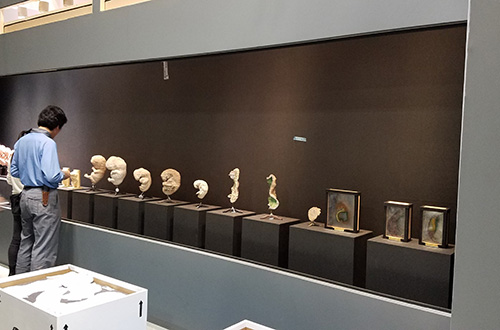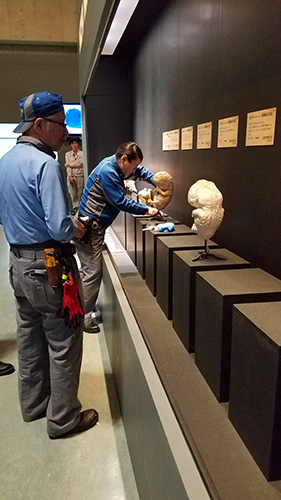Medical Museum's Carnegie Collection Models Showcased in Special Exhibit in Tokyo
By Lauren Bigge
NMHM Public Affairs Coordinator

Carnegie Collection of Embryology models from the National Museum of Health and Medicine's Human Developmental Anatomy Center are carefully packed for a special exhibit, "The BODY - Challenging the Mystery" at the National Museum of Nature and Science in Tokyo, Japan. (National Museum of Health and Medicine photo by Elizabeth Eubanks/Released)
Ten plaster and two acetate models from the Carnegie Collection of Embryology at the National Museum of Health and Medicine (NMHM)'s Human Developmental Anatomy Center (HDAC) were showcased in an exhibition on evolution at the National Museum of Nature and Science (NMNS) in Tokyo, Japan, from mid-March to mid-June 2018.
NMHM, a Department of Defense museum, was one of a prestigious list of international lenders that included Her Majesty Queen Elizabeth II's Windsor Castle; the Museum Boerhaave in Leiden, Netherlands; and the Cajal Institute, the Spanish National Research Council's neuroscience research center.
The NMNS's curator emeritus, Dr. Tadasu Yamada, contacted NMHM's HDAC collections manager, Elizabeth Lockett, in February 2017 to request a loan from the embryonic development-focused Carnegie Collection for a special exhibit: "The BODY - Challenging the Mystery."
Lockett identified Carnegie models that could safely be transported to Japan. Dr. Yamada made his selection during his August 2017 NMHM visit. Many of the models were too fragile to be placed on loan and there was an extensive criteria that had to be met, Lockett noted.
"Dr. Yamada wanted the Carnegie models specifically because they are the recognized standard for research in embryology," Lockett said. The Carnegie Collection, which concentrates on normal development of the embryo during the first eight weeks after fertilization, consists of an extensive collection of reprints from Carnegie Contributions to Embryology, collateral curatorial information about embryo specimens, and photographs in addition to plaster and acetate models.
NMHM registrar Elizabeth Eubanks oversaw the crating, transportation, safe handling, installation and de-installation of the models. She approved bases designed to withstand earthquake tremors, and an important last-minute lighting concept for a few models consisting of stacked drawings of embryo sections on acetate which resemble 3-D printed objects. Dr. Yamada told Eubanks that featuring the Carnegie models in an exhibit has been a long-term goal.
"In Japan, especially in universities or any type of institutions, people tend not to keep research-related materials once the scientist left the organization," Dr. Yamada said. "The actual fact that models have been kept for about/more than a hundred years [has] such an important meaning."
Dr. Yamada's team also requested from NMHM's archivist Laura Cutter a series of digital images of the brain of Albert Einstein for the exhibit section about the nervous system and brain. NMHM retains some original photographs of Einstein's brain and much original related documentation from pathologist Thomas Harvey.
"The BODY– Challenging the Mystery" attracted more than 495,000 visitors in 88 days, an exhibit organizer told Eubanks. "Among the half a million visitors to the exhibit were fairly many anatomists and/or people working in medical fields," Dr. Yamada said. "Visitors were impressed by the Carnegie Collection models and photos of Einstein's brain, to a degree according to their background."





